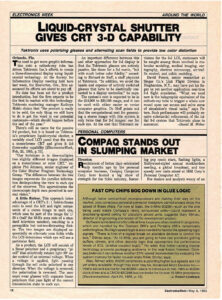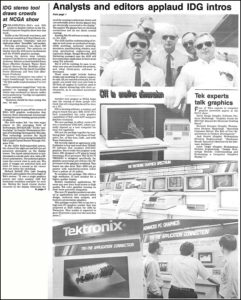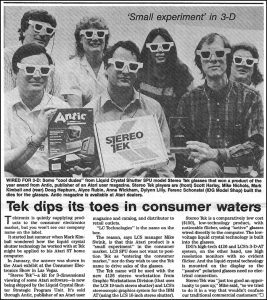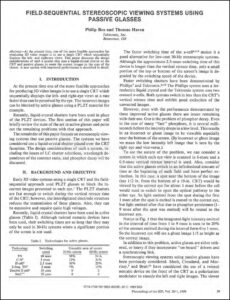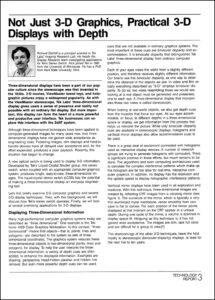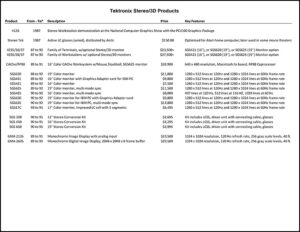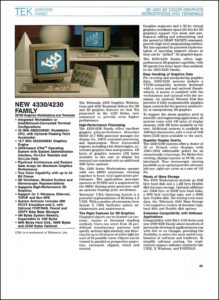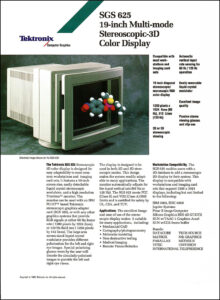In the early 1980's, when Tektronix was developing its award-winning liquid crystal color shutter technology, it became apparent that the fast light-switching technology used in the Tektronix color shutter had additional applications. In particular, high-quality stereo 3D imaging requires a fast light switch just like the one used in the color shutter. But instead of gating colors, the light switch in stereo 3D imaging is used to field-sequentially display two stereo image pairs—each with a different polarization. Special polarized glasses—called “passive” because like standard polarized sunglasses, they require no electronics—ensure that the left stereo image is only visible to the observer’s left eye, and the right stereo image is only visible to the right eye.
The first public mention of Tektronix’s interest in Stereo/3D viewing was an Electronics Week article dated May 6, 1985, which includes quotes by Kathy Middo, Phil Johnson, and Rick DeHoff. Click on the image to view the PDF.
The light-switching system was subsequently named the Liquid Crystal Stereo Shutter, or LCSS. A first demonstration using this technology was the 4126 graphics workstation. When wearing the passive glasses, one could see a full-color, stereo 3D image on the system monitor.
This March 1987 TekWeek article enthusiastically describes the 4126 graphics workstation as first seen at the National Computer Graphics show. The number of potential uses mentioned in the article includes mechanical design, solids modeling, molecular modeling, simulation, manufacturing robotics, mapping, geophysical engineering, and ergonomic design. Even fashion design and plastic surgery imaging are imagined as future uses. Click on the image to view the PDF.
Another 1987 technology demonstration was “Stereo Tek”, a set of active glasses with a very low price that was distributed by Antic. This May 1987 TekWeek article describes these "wired" glasses. Click on the image to view the PDF.
It was molecular modeling that provided the strongest market entry point for the LCSS. In 1989 Tektronix introduced the CAChe WorkSystem that provided a tool that chemists could use to build and visualize 3D models of complex molecules. More information is our CAChe WorkSystem page.
Also that year, Phil Bos and Tom Haven published a technical description of the LCSS system, detailing how the liquid crystal sequentially determines the light polarization states of sequential stereo image pairs. The LCSS system uses the same fast-switching liquid crystal pi-cell that was originally invented at Tektronix for the liquid crystal color shutter. The pi-cell switches optical states very fast, but not infinitely fast. A key consideration when designing LCSS systems is finding system configurations where the finite pi-cell switching speed does not cause light leakage to the eye meant to be blocked in a given field, producing unwanted “ghost images” to appear. Another challenge is that the pi-cell acts differently across the range of wavelengths in a full-color image—another source of unwanted “ghost images.” The Bos and Haven paper describes several techniques that were used to banish these “ghost images.”
This paper is courtesy of the Society for Information Display. © Society for Information Display. Click on the image to view the PDF.
A July/August 1986 Technology Report by Rick DeHoff, the lead display scientist for the Tektronix LCSS, provided a detailed explanation of the overall Tektronix Stereo 3D system. DeHoff’s report puts the LCSS in perspective and describes how it was a big improvement over the 3D systems of that time. Click on the image to view the PDF.
Throughout the late 1980s to the early 1990s Tektronix produced a variety of stereo 3D systems. In addition to molecular modeling, the products targeted applications that include remote sensing, photogrammetry, non-destructive testing, and medical imaging. A list of these products is detailed in the following spreadsheet. Click on the image to view the PDF.
Additional information about the 4200/4300 Family of Terminals and Workstations is shown in this excerpt from the 1988 Catalog. Click on the image to view the PDF.
The illustration of the SGS 625 19” monitor on the datasheet shows the Stereo/3D concept. Click on the image to view the PDF.
In 1991, the CAChe business was spun out of Tektronix and several years later was acquired by Oxford Molecular Group. The LCSS technology was also licensed to the NuVsion subsidiary of Vikay, a Singapore company. Both passive and active glasses products were developed and sold by NuVision. Boyd McNaughton, a former Tektronix employee, eventually bought the NuVision technology forming McNaughton-NuVision to continue development and sales of stereo 3D systems with an emphasis on satellite imaging applications. The LCSS technology was later sold by McNaughton-NuVision to Expand Co.
Shutter production for Tektronix Color and Stereo products continued at Maxtek, a joint venture of Maxim and Tektronix, through 2010.

